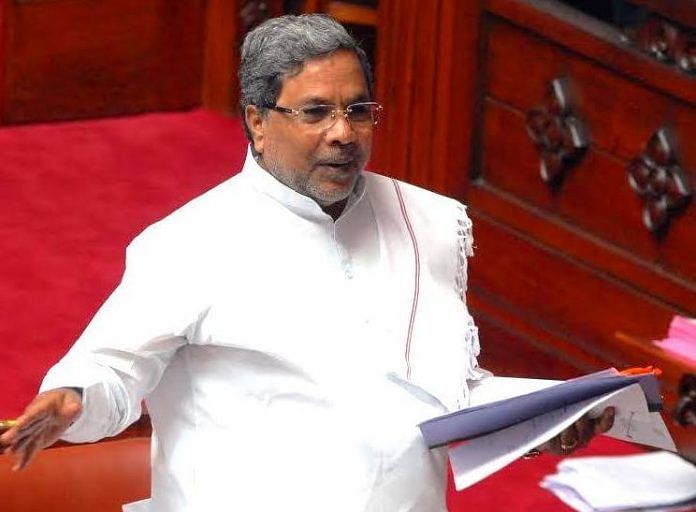The Karnataka CM has no substantial accomplishments despite being in power for 4 years. But he is banking on a social engineering formula to fend off BJP.
Prithvi Datta Chandra Shobhi
With elections in Karnataka less than 10 months away, there appears to be some good news for the beleaguered Congress party which is being steamrolled elsewhere by the Modi-Shah juggernaut.
The natural question then is how has the Congress managed to remain relevant in Karnataka. Its chief minister, Siddaramaiah, hasn’t created any national buzz during his four-year tenure. As his party gets politically decimated in election after election, he has become perhaps the most important non-NDA chief minister along with Mamata Banerjee. Yet, he hasn’t waded into national issues, either on the intolerance debate or on policy issues such as GST. He may have criticised Modi aggressively in Karnataka but hasn’t sought the mantle of Modi’s critic-in-chief.
On the contrary, Siddaramaiah appears to have consciously shunned national attention, unlike Chandrababu Naidu or Nitish Kumar. Rarely has he given interviews to the English media. In fact, no one accuses him of cultivating the media, national or local. Even when his government organised an ambitious international conference called ‘Quest for Equity’ last month in Bengaluru, to commemorate Dr. B.R. Ambedkar’s 125th birth anniversary, the event was barely publicized.
There is no governance doctrine bearing his name. Nor is there any discussion of a Karnataka model of development. If Congress was looking for a governance model for its national revival, its state government in Karnataka hasn’t provided that. Siddaramaiah appears to have placed his trust in that old adage ‘all politics is local’.
Also given the high command centric culture of the Congress, Siddaramaiah realises the importance of maintaining a low-key presence.
Curiously enough, Siddaramaiah was known for his administrative acumen. Yet his government hasn’t been effective in curbing corruption, attracting private capital or creating infrastructure. Despite significant investments in irrigation, Siddaramaiah hasn’t done much to help the agricultural sector, now experiencing a third consecutive drought. He hasn’t had much success in managing Bengaluru’s garbage disposal problem or women’s safety. Bengaluru, which contributes more than half of Karnataka’s GDP and taxes, continues its explosive growth but its infrastructure remains severely inadequate. The anti-superstition bill languishes in its draft form.
Siddaramaiah’s unimpressive national profile or lack of substantive accomplishments stand in stark contrast to his near-indispensability politically to Karnataka Congress. This is stunning when you consider that he is a socialist from the Janata parivar and entered the party only in 2005. His fellow Congressmen haven’t forgotten Siddaramaiah’s three-decade long strident anti-Congress politics. Yet they haven’t publicly challenged his leadership. There remains some resentment over the distribution of spoils of office, but dissidents have wanted to join his cabinet, not topple it. He changed his mind about retiring from electoral politics in 2018 and now wants to lead the Congress campaign.
How has Siddaramaiah primed Congress to be competitive? A lack of challengers to his leadership has helped. But answers perhaps lie elsewhere.
Consider Siddaramaiah’s own simple political argument. In numerous advertisements during the fourth anniversary of assuming office, Siddaramaiah claimed that his government has already implemented more than 95 per cent of the promises made in its election manifesto. The Congress manifesto, not substantially different from that of its main rivals, focused mostly on social welfare programmes. Even then, Siddaramaiah has aggressively implemented Annabhagya (free distribution of food grains to BPL families) and the SCSP/TSP Act, 2013, according to which planned budgetary expenditure has to be spent on SC and ST groups in proportion to their population. Such funds cannot be diverted, which has resulted in large subsidies being given for self-employment and education. Beneficiaries of such schemes have largely been OBC, Dalit and minority communities.
It is this social coalition that Siddaramaiah wants to retain for Congress in Karnataka. Recall that he left JD(S) in order to secure an AHINDA (Minority, Most Backward and Dalit) following. He has adroitly cultivated that base in these four years, thereby questioning the political dominance of the upper castes. Soon after assuming office, Siddaramaiah commissioned a socio-economic survey of caste groups, which is effectively the first caste census since 1931. Leaked reports suggest that the SCs, STs and minorities may constitute half of Karnataka’s population, whereas the dominant Lingayat and Vokkaliga communities may be substantially smaller than previously believed. Siddaramaiah is expected to use these figures to make the political case for a greater share of political power to the AHINDA communities.
But, Siddaramaiah hasn’t left Lingayats and Vokkaligas untouched. In recent weeks, Siddaramaiah has sought to split the powerful Lingayat community, which has been the BJP’s mainstay for nearly two decades, by offering to recommend to the Central government that they be recognised as a religious minority. Supporting this long-standing demand of Lingayats may help the Congress split the Lingayat vote and retain its base in north Karnataka. Siddaramaiah has also weaned away some dissident Vokkaliga JD(S) legislators, striking at the Deve Gowda stronghold in southern Karnataka.
Does the Siddaramaiah approach offer a more sensible path for Congress’ national revival?
Prithvi Datta Chandra Shobhi is a Mysore-based social historian and political commentator.



